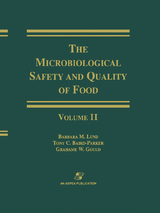Microbiological Safety and Quality of Food
Aspen Publishers Inc.,U.S. (Verlag)
978-0-8342-1323-4 (ISBN)
Principles And Application Of Food Preservation Techniques: Production Of Microbiologically Safe And Stable Foods. Strategies for Food Preservation. Heat Treatment. Irradiation. Chill Storage. Freezing. Drying and Reduction of Water Activity. Control of PH and Use of Organic Acids. The Use of Other Chemical Preservatives: Sulfite and Nitrite. Modified Atmospheres. The Effect of Redox Potential. Microorganisms and Their Products in the Preservation of Foods. New and Emerging Physical Methods of Preservation. Use of Combined Preservative Factors in Foods of Developing Countries. Injured Bacteria. Principles and Application of Predictive Modeling of the Effects of Preservative Factors on Microorganisms. MICROBIAL ECOLOGY OF DIFFERENT TYPES OF FOOD. Fresh Red Meats. Processed Meat Products. Fermented Meats. Fresh and Further-Processed Poultry. Fresh and Processed Fish and Shellfish. Milk and Unfermented Milk Products. Fermented Milk Products. Eggs and EggProducts. Fresh and Processed Vegetables. Fermented and Acidified Plant Foods. Fresh and Processed Fruits. Cereals and Cereal Products. Yellow-Fat Products. Mayonnaise, Dressings, Mustard, Mayonnaise-Based Salads and Acid Sauces. Fruit Juices, Fruit Drinks, and Soft Drinks. Bottled Water. Spices and Herbs. Nuts and Nut Products. Sugar, Honey, Cocoa, Chocolate and Confectionery Products. Teas, Herbal Teas and Coffee. FOODBORNE PATHOGENS. Surveillance of Foodborne Disease. The Aeromonas Hydrophila Group. Bactillus Spp. Campylobacter. Clostridium Botulinum. Clostridium Perfringens. Escherichia Coli. Listeria Monocytogenes. Salmonella. Shigella. Staphyloccus Aureus. Vibrio Spp. Yersinia Spp. Less Recognized and Suspected foodborne Bacterial Pathogens. Protozoa. Foodborne Viruses. Toxigenic Fungi And Mycotoxins. Fish and Shellfish Poisoning. Long-Term Consequences of Foodborne Disease. Economic Costs of Foodborne Disease. Transmissible Spongiform Encephalopathies. ASSURANCE OF THE MICROBIOLOGICAL SAFETY AND QUALITY OF FOODS. Good Manufacturing Practice, HACCP and Quality Systems. Hygienic Design o Factories and Equipment. Sampling for Microbiological Analysis. Detection of Microorganisms in Foods: Principles of Methods for Separation and Associated Chemical and Enzymological Methods of Detection. Detection of Microorganisms in Foods: Principles of Culture Methods. Detection of Microrganisms in Foods: Principles and Application of Immunological Techniques. Principles and Application of Genetic Techniques for Detection, Identification and Subtyping of Food-Associated, Pathogenic Microorganisms. Risk and Microbiological Criteria
| Zusatzinfo | LIV, 2024 p. In 2 volumes, not available separately. |
|---|---|
| Verlagsort | Philadelphia |
| Sprache | englisch |
| Maße | 210 x 279 mm |
| Themenwelt | Naturwissenschaften ► Biologie ► Mikrobiologie / Immunologie |
| Technik ► Lebensmitteltechnologie | |
| ISBN-10 | 0-8342-1323-0 / 0834213230 |
| ISBN-13 | 978-0-8342-1323-4 / 9780834213234 |
| Zustand | Neuware |
| Haben Sie eine Frage zum Produkt? |
aus dem Bereich




